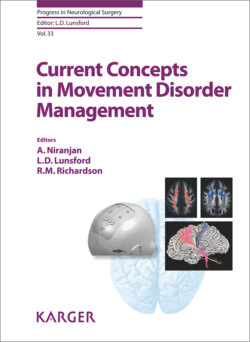Читать книгу Current Concepts in Movement Disorder Management - Группа авторов - Страница 73
Dystonia
ОглавлениеDystonia is characterized by involuntary muscle contractions resulting in abnormal movements or postures. Dystonia can affect any of the body, and may result in sustained, rhythmic, or task-specific involuntary muscle contractions. Dystonia can occur on its own or be part of a syndrome [21]. Correspondingly, etiologies vary. Based on phenomenology, a new consensus proposed a syndromic approach to guide diagnosis [21]. With regard to treatment, in addition to physical and supportive therapy, oral medications and botulinum toxin sum up the current options for these cases [22–24]. Finally, stereotactic surgery targeting the internal segment of the globus pallidus has been shown to be efficacious in the treatment of primary generalized and segmental dystonia, in both adults and children, as well as in cervical dystonia and craniofacial dystonia that does not respond to conservative treatment with medications and botulinum toxin (BoNT) injections.
Trihexyphenidyl and other anti-cholinergics have their efficacy documented for decades in reducing the severity of various forms of dystonia. Typically, the total daily dose is limited due to peripheral and central side effects, such as vision disturbances, constipation, dry mouth, and cognitive slowing. A slow titration is recommended. Children usually tolerate higher doses than adults (8–12 mg daily for trihexyphenidyl) [22–24].
Treatment with GABAergic agents also provides some relief of dystonic symptoms. Benzodiazepines (clonazepam, diazepam, and lorazepam) are usually effective, although sedation limits their dose. Oral baclofen, which activates the GABA-B receptor, is also used in the treatment of dystonia. Intrathecal baclofen has been shown to be effective in reducing associated spasticity, particularly in the legs. Most of the patients are treated with a combination of the highest tolerated dose of each medication. In addition, patients with early onset dystonia should always be trialed with levodopa to rule out dopa-responsive dystonia [22–24].
BoNT is safe and effective in a variety of forms of focal dystonia. By interfering with vesicle fusion, BoNT inhibits the release of acetylcholine at the neuromuscular junction. Serotypes A and B are available for therapeutic purposes. Three different brands of serotype A and 1 brand of serotype B are commercially available in the United States (Onabotulinumtoxin A, Rimabotulinumtoxin B, Abobotulinumtoxin A, Incobotulinumtoxin A). The various brands of BoNT have different dosing guidelines and storage requirements, and thus are not interchangeable. The most important factors in determining the success of treatment with BoNT is the appropriate selection of muscles and accurate injection of the adequate dose. Muscle selection should be based on the determination of the primary abnormal position and knowledge of the insertion sites of the corresponding muscles that when contracting produce the abnormal position. Electromyography guidance may improve the accuracy of muscle selection and targeting [22–24].
